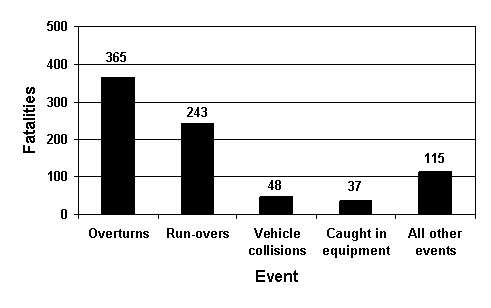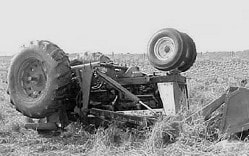Worker Safety on the Farm
April 2010
DHHS (NIOSH) Publication Number 2010-137

U.S. Farm Operations and Adult Farm Workers*
- In 2007, 2.2 million farms were in operation in the U.S.
- Approximately 5.3 million adults worked on U.S. farms in 2004, including 1.8 million hired workers and 3.5 million adult family members.
- The majority of farms in the U.S. do not utilize hired workers. Less than 20% (434,000) of farms reported having hired workers 20 years of age and older.
- In 2006, an estimated 59% of the 4.2 million tractors in use were equipped with a roll-over protective structure (ROPS).
* Worker counts and non-fatal data were obtained from the 2004 Occupational Injury Surveillance of Production Agriculture. Worker and injury counts exclude contract laborers.
Non-fatal Adult Work-related Farm Injuries, 2004*
- An estimated 80,300 work-related injuries occurred to adults on farms (9.2 injuries every hour).
- Almost 75% (58,600) of the injuries were to adults living on the farm.
- The most common types of injuries were sprains, strains, and torn ligaments (22%), fractures (15%), and cuts (13%).
- The most common sources of injury were animals (16%), the ground (16%; usually from falls), and tractors (5%).
* Worker counts and non-fatal data were obtained from the 2004 Occupational Injury Surveillance of Production Agriculture. Worker and injury counts exclude contract laborers.
Fatal Adult Work-related Farm Injuries, 2003-2007**
- From 2003 to 2007, 2,233 workers 20 years of age and older died in agricultural production 25.9 deaths/100,000 workers).
- Twenty-seven percent (603) of deaths were to hired workers.
- Of the 2,233 workers who died on farms, 40% (888) were 65 years of age or older.
- Tractors were the most common source of fatalities (36%), and overturns were the most common cause of death (365 deaths).
**Fatality data were obtained with restricted access to the Bureau of Labor Statistics, Census of Fatal Occupational Injuries. Calculations by NIOSH may differ from those published by BLS and views expressed here do not necessarily reflect the views of BLS.
Adult Work-related Tractor Fatalities in Agriculture by Event, 2003-2007**

**Fatality data were obtained with restricted access to the Bureau of Labor Statistics, Census of Fatal Occupational Injuries. Calculations by NIOSH may differ from those published by BLS and views expressed here do not necessarily reflect the views of BLS.
Tractor Safety
- All tractors should be equipped with a rollover protective structure (ROPS). Limit use of tractors not equipped with ROPS.
- A seatbelt should always be used when operating a tractor equipped with ROPS.
- Avoid crossing slopes whenever possible and use appropriate speeds for operating conditions.
- Do not allow extra riders on tractors and other farm equipment; follow the “ONE SEAT-ONE RIDER” rule*.
- Hitch only to the drawbar and hitch points that the manufacturer recommends.
- When transporting materials using a loader, keep bucket in lowered position.
- Lower hydraulic equipment to the ground when not in use; if the hydraulic lines lose pressure raised equipment can lower suddenly—crushing anything, or anyone, underneath.
- Use available handholds and care when getting on or off the tractor; slips and falls cause injuries.
- Know and follow medication labeling; some medications may impair judgment and/or ability to operate vehicles or machinery.
- Always start the tractor from the operator’s seat with the transmission and power takeoff in neutral and the parking brake engaged. You should never bypass-start a tractor.
- Ensure that tractors are properly shut down after each use.
* Training seats are designated for training purposes only.
Machinery Safety
- Familiarize yourself with specific hazards associated with your machinery and ATV. Safe operating procedures are available in the owner’s manual.
- Do not carry passengers on ATVs designed for a single rider.
- Be aware of the risk of overturn when operating an ATV. Use extra caution on uneven terrain and ensure that all loads are appropriately balanced.
- Avoid wearing loose clothing or jewelry and keep hair tied back when operating machinery.
- Ensure completion of regular machine maintenance and inspection of safety guards.
- Do not make modifications to machinery not recommended by the manufacturer, including removing safety shields.
- Always wear appropriate personal protective equipment (PPE) when operating machinery, for example helmets with ATVs.
Animal Safety
- Avoid quick movements and loud noises when working around animals.
- Be aware of animal behavioral characteristics.
- Movement in an animal’s blind spots may startle it.
- Animal pens should include person-gates to allow for a quick escape.
- Always maintain an escape route when working with animals in close quarters, such as chutes and stalls.
- Use corral designs that facilitate the safe movement of animals.
Fall Safety
- Do not overextend your body when working from a ladder or scaffolding.
- Ladders and scaffolding should be in good repair and positioned appropriately.
- Utilize the “three-point system,” meaning that three of your four limbs are in contact with the ladder or vehicle at all times, either one hand and two feet, or two hands and one foot.
- Inspect your farm regularly. Provide adequate lighting and make sure floors are properly cleaned.
- Shoes should have slip resistant soles and low heels.
- All hay and grain chutes and openings should be securely covered when not in use.
- Open elevated spaces should be guarded by a fixed railing: top-rail, mid-rail, and toeboard.
Hired Worker Safety
Farm operators who hire workers should be aware of all applicable labor laws.
- Provide relevant training for each employee and follow-up with direct communications to ensure understanding.
- Provide direct supervision when workers are performing dangerous duties, particularly when the worker is new to the activity.
- Ensure there are no language barriers limiting the effectiveness of training or supervision.
Man Dies in Tractor Overturn
 2005 — A man was crushed when the tractor he was operating with a full load of rocks in the front-end loader overturned. The older tractor with a tricycle front axle was not equipped with a ROPS and did not have counterweights installed. With the bucket raised to nearly hood height, the operator drove it forward at a slight upward angle on an uneven slope causing the tractor to suddenly overturn.
2005 — A man was crushed when the tractor he was operating with a full load of rocks in the front-end loader overturned. The older tractor with a tricycle front axle was not equipped with a ROPS and did not have counterweights installed. With the bucket raised to nearly hood height, the operator drove it forward at a slight upward angle on an uneven slope causing the tractor to suddenly overturn.
Worker Safety on the Farm [PDF 476KB]
For More Information
National Agricultural Safety Database
National Safety Council
National Education Center for Agricultural Safety
Telephone: 888-844-6322
U.S. Department of Labor
Telephone: 1-866-4-USA-DOL
